| Please access the following URL if you want to secure using SSL. All pages in the site will be secure pages. |
https://secure02.blue.shared-server.net/www.fish-food.co.jp/message english 7.2022.html |
Welcome to FISH FOOD TIMES
Jul. 2022 issue No.223

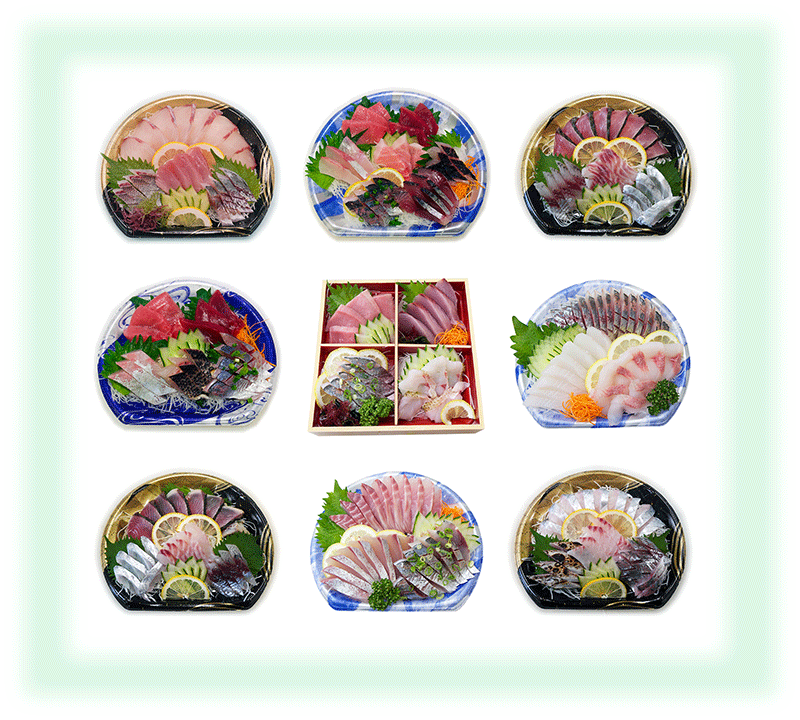
Rethink Syunsen assorted sashimi
The soaring prices of farmed fish do not stop
Recently, it can be said that almost all prices are rising in the world, and farmed fish are no exception. Let's take a look at the price changes of typical farmed fish in the Toyosu market. "Below, the graph of gdfreak is the Toyosu market price transition of the Tokyo Metropolitan Central Wholesale Market Daily Report and Market Statistics Information."
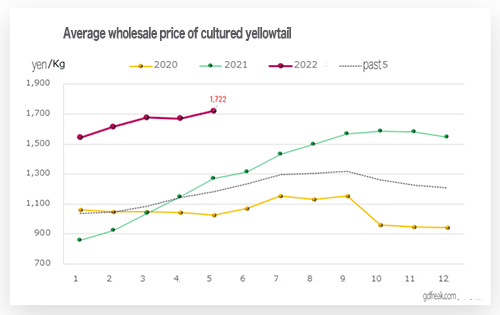
In the case of farmed hamachi, one of the reasons for the recent price increase is that the amount of yellowtail fry two years ago was unfished, and the amount of two-year-old fish in the pond decreased. After a period of extreme stagnation in demand, the price of cultured yellowtail, which had been sluggish for a long time, turned to an upward trend and is now the highest price in history.
Next is amberjack.
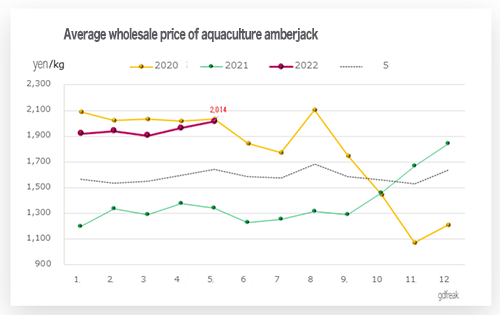
Amberjack has been affected by the slump in demand due to the new coronavirus, and has continued to have an unprecedented price slump for about a year from the latter half of 2020. However, by the latter half of 2021, the price started to rise in line with the farmed yellowtail, and it seems that the price was almost restored to what was once regarded as a high-class fish.
Next is red sea bream.
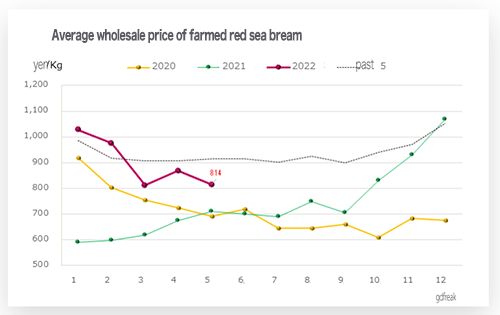
Red sea bream, like amberjack, turned to an upward trend from the latter half of 2021. It is speculated that the recent price decline is related to the seasonal factor of the year, which is affected by the price because it is the time when many natural sea breams are caught. However, it is the same as yellowtail and amberjack that the price has been the highest in the last few years.
Next is imported salmon and trout.
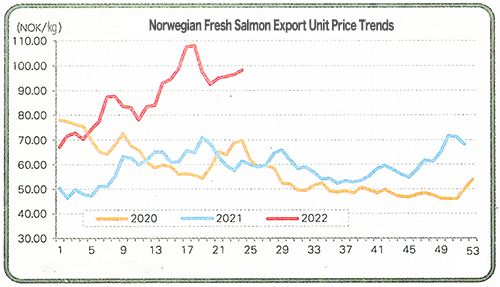
The local export price of Norwegian salmon, which is mainly used for raw food such as sashimi and sushi, was 98.43 kroner / kg in the 24th week from June 13th (Monday) to June 19th (Sunday). One krone is 14 yen, so when converted to Japanese yen, it is 1,378 yen / kg. With the addition of air transportation logistics costs and trading company margins, prices continue to rise without knowing the ceiling. And if you look at the graph below, you can see that the prices of imported salmon, including Norwegian airlift salmon, are generally rising in the Toyosu market, in response to the graph above.
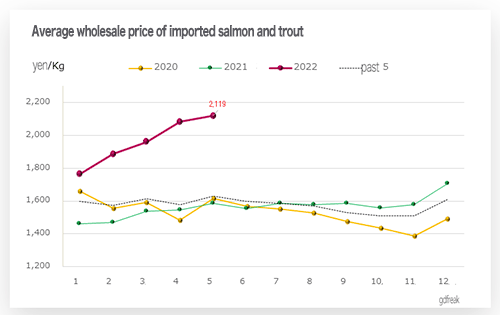
Next is the cultured bluefin tuna.

As with the amberjack, the demand for this cultured raw bluefin tuna fell due to the influence of the new coronavirus, and the price was also sluggish. However, it seems that the market has recently revived to the original high-class fish market and has become a bullish price formation.
Assorted sashimi using soaring farmed fish
As we have seen above, let's calculate what it would be like to make assorted sashimi using farmed fish that are still soaring. Below is an image of an example I created in the past. I think that the price of raw materials for this product varies depending on the scale of the business such as supermarkets, the power relationship with business partners, the frequency of use and likes and dislikes depending on the region, and other conditions. For the time being, I would like to make a calculation based on the current market price as described above, without taking into consideration those individual environments.
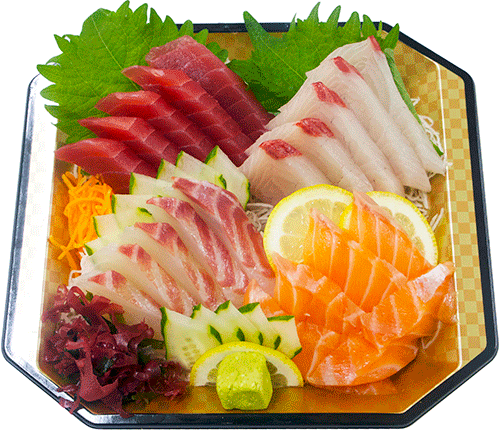
A specific example is the case of assorted sashimi with the four types of fish in the above image. I think there are differences depending on the thoughts of the person in charge of sashimi and the sashimi making manuals of each company, but basically the average size is not so thin, and the weight of one piece is unified to 12g.
First, the tuna on the upper left. I created this on June 16, 2016, but I remember it was probably a raw yellowfin tuna. However, the price of raw yellowfin tuna fluctuates greatly depending on the freshness and market price, so I would like to set it as lean fish of cultured raw bluefin tuna according to the theme of this month's issue. There are various types of purchase of cultured raw bluefin tuna such as GG (Gilled and Gutted), loin, block, and strip, but this time we will calculate with GG, which is the cheapest in terms of price.
47 kg of cultured raw bluefin tuna GG was purchased at 3,000 yen / kg, the net weight was 25.2 kg, and the yield rate was 53.6%. The composition ratio is red fresh 22%, medium fatty tuna 50%, and large fatty tuna 28%. In order to review the simple calculation result in this case, the cost is calculated by utilizing the "converted cost variable" that is set arbitrarily. The converted cost of each is 3,600 yen / kg for red fresh, 5,400 yen / kg for medium fatty tuna, and 7,500 yen / kg for large fatty tuna, so the total cost is 140,874 yen, which is almost the same as the purchase price of GG, 141,000 yen. As a result, the cost of 12g per slice is red fresh 43.2 yen, medium fatty tuna 64.8 yen, and large fatty tuna 90.0 yen. The cost of the target red fresh is rounded up and one slice is regarded as 44 yen.
Next is the amberjack on the upper right. It is assumed that the size of amberjack is 4 kg, and the yield rate of strip without skin is 45%. I think there is some disagreement about the setting of the yield rate, but I think that there is no big problem if it is this value on average. Assuming that the latest purchase price is 2,014 yen kg in the graph above, the strip is about 448 yen / 100g, so one piece of 12g is 53.8 yen, so it is about 54 yen.
The red sea bream on the lower left is a convenient 1.5kg size. Assuming that the yield rate of strip without skin is 35%, the latest market price is 814 yen / kg, so strip is about 233 yen / kg, so 12g per slice is 27.96 yen, so it is about 28 yen.
In the case of raw atlan salmon in the lower right, it is difficult to make a concrete example using the graph above, so I would like to use the example taken in the May 2022 issue of FISH FOOD TIMES No.221. If the Norwegian airlift Atlan salmon trim C in a vacuum bag is used as a sashimi strip, the yield rate is assumed to be 85%. If the purchase price is 3,000 yen / kg, the yield cost will be 3,529.4 yen / kg, so the cost per 100g will be about 353 yen. One piece of 12g is 42.3 yen, so it's about 43 yen.
The total of raw materials, trays, ashirai, etc. is as follows.
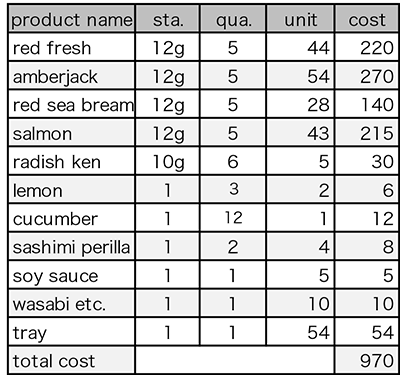
The cost of assorted sashimi with the four types of fish in the above image was 970 yen. Now, looking at this calculation result, what kind of selling price will readers put on this product? It is difficult to simply set the markup ratio to 50%, and 30% is too low, so if you set it to 40%, the calculation result will be 1,616.6 yen / kg, so it will actually be 1,680 yen.
I think that the market price would have been 980 yen if the selling price was to be set with the conventional sense, but it is better not to make it because it is only the cost. Moreover, since the farmed bluefin tuna is a GG standard, it is the lowest price calculation, so if the purchase is in the expensive loin unit that was dismantled in advance, or if the site can only handle strips in terms of ability, Further costs will be added.
Therefore, if you reduce the sashimi to 10g cut for the purpose of reducing the cost price,
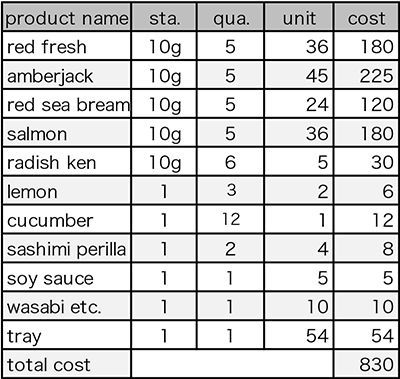
If you cut the sashimi thinner than this, it will become usutsukuri sashimi. If the minimum size of 10g for hiratsukuri sashimi is set, the total cost is 830 yen, and if the markup ratio is secured at 40%, it will be calculated as 1383.3 yen / kg, so the selling price will be 1,480 yen.
If this still doesn't work as a selling price, the last method is to cut the number of sashimi into four pieces. You know that the number 4 is not generally auspicious. From ancient times, odd numbers have been considered auspicious in Buddhism, and even numbers have been avoided. In other words, sashimi is basically served in 3 or 5 slices, and there is a tradition of Japanese food that 4 slices have been avoided. However, few people know such a thing now, and on the contrary, if it is 4 pieces, it tends to be preferred because it can be divided into half by two people. I have to admit that even in the workplaces where I am involved, it is becoming common sense to have a mountain of four pieces.
So, if you reduce the hiratsukuri sashimi to 4 slices of 10g thin,

If you make assorted sashimi with the four types of fish in 10g4 pieces, the total cost will be 689 yen, and if you secure 40% markup ratio, it will be 1,148.3 yen / kg, so the selling price will be 1,180 yen.
As we continue to cut costs in this way, each time it becomes less attractive, the value of the product is diminished, and its sales become less favorable.
Cost cut and ease of purchase, its limits
The word "unsatisfactory sales" is not very comfortable. However, sales in the fishery sector have not been heard as "not so bad" or "so-so ..." after the special demand for the new coronavirus has passed.
Below are the preliminary figures of the numbers sold by supermarkets located all over the country in May. Unfortunately, the fishery division is lower than the prepared foods division in terms of sales composition, and the year-on-year rate of sales continues to decline, making it the number one drag on the overall market.
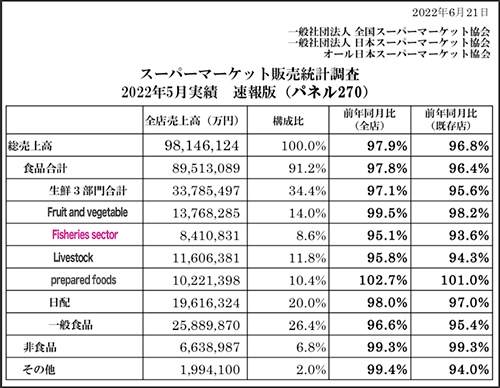
Ten years ago, when I looked up the position of the fishery sector in the same statistical survey, the following facts were recorded.
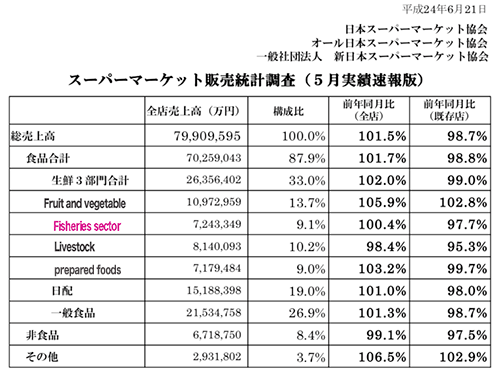
Ten years ago, the fisheries sector accounted for 9.1% and the prepared foods sector accounted for 9.0%, slightly above. But now the composition ratio for fisheries fell 0.5% to 8.6% last month, and the prepared foods sector rose 1.4% to 10.4%, a complete reversal in the last decade. In the last 10 years, sales of the fisheries sector have increased by about 16%, but sales of the prepared foods sector have increased by 42%, and sales of livestock have also increased by 42%.
Why did this happen? The author's thoughts are described in FISH FOOD TIMES January 2022 No.217 regarding the factors behind the slowdown in sales in the fishery sector. I would like to avoid repeating the same thing in this month's issue. Thinking about that problem from a different perspective, I would like to find a way to overcome the ongoing "long-term decline trend in the fisheries sector."
For example, how to accept and deal with the soaring prices of farmed fish mentioned above. For example, in order to cut costs, the size of a piece of sashimi can be reduced to 10g instead of 12g, or the number of servings can be reduced to 4 instead of 5. Furthermore, anyone can immediately omit the cucumbers, lemons, seaweeds and perilla used for ashirai as wasteful decorations, or change the trays to cheaper ones. However, this is a method that cannot be helped even if it is said that it is incompetent.
In order to realize an easy-to-buy price, it is an impairment of value to reduce the attractiveness of products one after another. It is to reduce its value by one's own actions, and at the same time, it is nothing but to lower the satisfaction of customers. As long as we continue to use such methods, we will surely hit the limits and there will be no bright future for the fisheries sector in that direction.
Products should always be appealing and increase in value to give customers a sense of satisfaction, and the products must be evolved so that they can receive a reasonable price for that.
In other words, the assorted sashimi with the four types of fish in the image above should not take the direction of cutting costs and making it sell cheaply, but on the contrary, the content should be qualitatively enhanced. I think that we should propose a product that customers can say, "If it is this content, this selling price is not high at all." Regarding the direction, we have made a number of proposals as the main theme in FISH FOOD TIMES.
The method of increasing customer satisfaction in this way tends to increase the selling price. However, on the other hand, it seems necessary to think about ways to make customers feel satisfied in a different way by changing their thinking a little.
Rethinking the significance of syunsen assorted sashimi
This FISH FOOD TIMES started in January 2004, and this month's issue became No. 223, which is the 6th month of 18 years. The image at the beginning of the first issue is syunsen assorted sashimi. At that time, the author wanted to ask the world about the significance of this product in my own way, so I set up this homepage on own, without the help of professionals on the road.
I dared to paste the following in the screenshot way so that readers can see the site as it was at the time, without hiding the poor structure and lack of content.

続いて、3月号でも旬鮮刺身盛り合わせのことについて記していた。
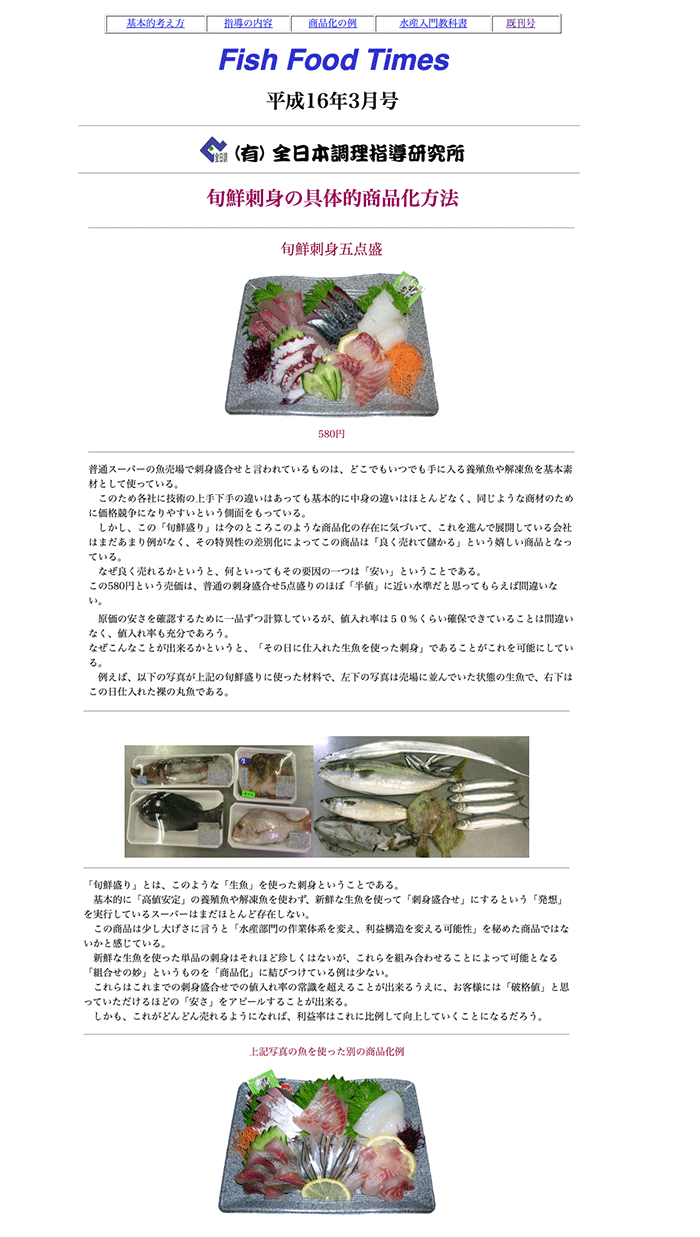
I would like to describe the origin of syunsen assorted sashimi described here. It made assorted sashimi using farmed fish and thawed fish, which are stably available at that time and have high purchasing costs. However, even though the markup ratio is not so high, the selling price is not always cheap, so the purpose was to solve the on-site problem that even if you make assorted sashimi after all, it will not be profitable in the end.
In the early days as shown in the image above, syunsen assorted sashimi was the idea of simply replacing the farmed fish and thawed fish that are the materials of assorted sashimi with natural fish. After that, I proposed various forms of syunsen assorted sashimi while trying various creation methods, but the calm form is the commercialization method as shown in the opening image of this month's issue.
For example, one of them is this,
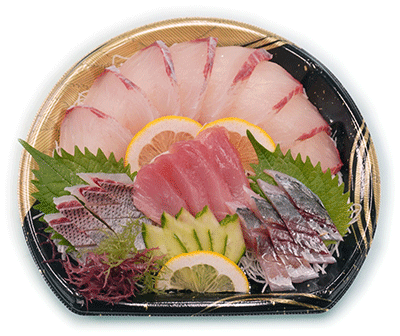
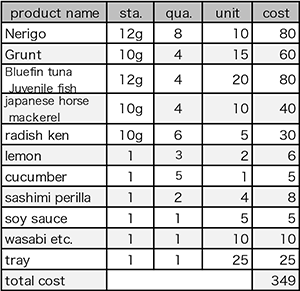
Assorted sashimi using 4 kinds of fish, the cost is calculated as 349 yen as shown in the table on the right. This is an assumption that natural fish was purchased at such a price, but of course it is a practically feasible price. If you calculate with a markup ratio of 40%, it will be 581.6 yen, so the selling price is expected to be 580 yen to 680 yen, but if it is 680 yen, you can secure a markup ratio of 48.7%.
The same 4 types as assorted sashimi, which uses 4 types of farmed fish, but the difference is that all the ingredients are natural fish. Another difference is that the cheapest of the four types of natural fish, Nerigo (amberjack fry), is served twice as much as the other fish to create volume. This makes it more quantitatively attractive than assorted sashimi with the four types of fish.
Not only is this syunsen assorted sashimi attractive in quantity, but it can also be sold at a selling price of 680 yen while securing a markup ratio of nearly 50%. In this case, compared to the assumed selling prices of 1,680 yen, 1,480 yen, and 1,180 yen for assorted sashimi with the four types of fish in the above image, overwhelming cost performance can be realized.
This is a different part from the previous method of creating syunsen assorted sashimi. By making good use of the difference in the purchase price depending on the fish species, instead of making four piles of sashimi of the same size, select the fish that stands out as much as possible at the cheapest purchase price and place it at the other end. By doing this, the feeling of volume can be increased.
Next, let me introduce another two examples.
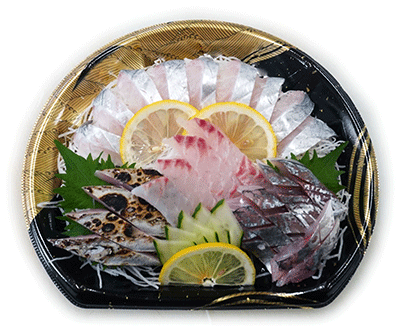
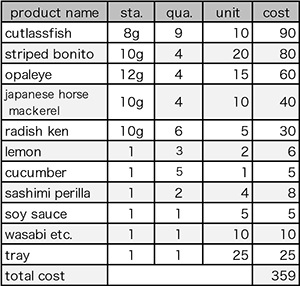
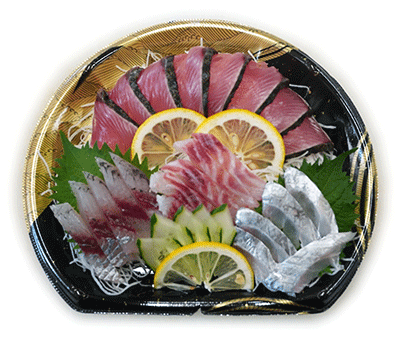
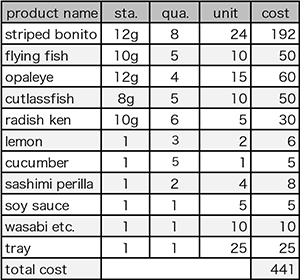
In this way, the fish species to be served have changed, but the idea and method are the same, so I would like to avoid repeated explanations.
Comparing the three types of syunsen assorted sashimi in this way, although the method of serving is the same, not only the appearance but also the cost changes to 349 yen, 359 yen, and 441 yen by changing the fish species. Since syunsen assorted sashimi basically uses raw fish whose purchase price fluctuates, its cost will change every day accordingly.
In other words, the point is how well you can control raw fish whose purchase price fluctuates and use it for sashimi. The person in charge of sashimi needs to have the judgment to make an appropriate decision by looking at the fish that arrived that day. Specifically, it has the technical ability to use hiratsukuri sashimi and usutsukuri sashimi properly for each fish species, and the ability to calculate which fish species and which fish species should be combined to reduce the selling price and secure a high markup ratio. Then, it is required to have the ability to apply them to make them attractive products by making good use of them.
Originally, assorted sashimi is a product of excellent human resources with high ability to do such things normally, and you can fully enjoy the taste of ripe fruits by "the splender of the combination". It will benefit the fisheries sector.
However, under the slogan of rationalization, efficiency, and labor saving, the fish department of the supermarket at this time strongly promotes the female part of sashimi product manufacturing, and in order to realize that, stably available farmed fish and thawed fish. We have prepared a manual that assumes the use of fish. And in the sashimi corner of the fish counter, there are always sashimi that are made of fish with similar faces a year ago, half a year ago, and yesterday and tomorrow. Even if it is sashimi made by a new part-time employee, it has the same selling price as the sashimi of a good person, so there is also the problem that it is difficult to increase sales due to appearance problems.
The fishery sector has a high sales composition ratio in the sashimi product class, and if it is highly evaluated by customers, the fishery sector has a relatively high profit margin and often has excellent division profit and loss. However, as a result of rationalization, efficiency, and labor saving according to the company policy, not only sashimi products but also other fish products cannot be sold, so the composition ratio in the store will continue to be lowered for a long time. For this reason, the fishery sector, which is considered to be a store's burden, cannot easily get out of the deficit.
Upgrade of syunsen assorted sashimi
Sashimi products are "professional world jobs" that cannot be easily done even if an untrained person says "Come on, make sashimi!". syunsen assorted sashimi is a good teaching material for measuring the ability of sashimi staff, and in order for the human resources to fully demonstrate their abilities, the existence of an excellent manager who divides the fishery department is also important, and their cooperation If the play goes well, the attractive syunsen assorted sashimi will be realized in the fish counter.
However, syunsen assorted sashimi gets tired of repeating the same pattern. Once the base method is established, we should try to increase sales by taking the next step. For example, I think it would be good to have a product with a large amount of 3 items as shown below. Name it "syunsen assorted sashimi tattpuri"
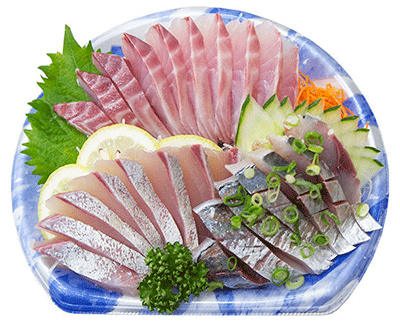
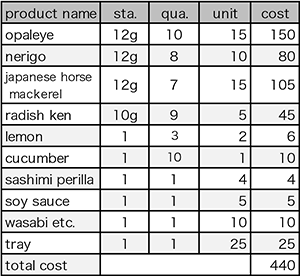
Next is how to steer in the opposite direction. Syunsen assorted sashimi that minimizes the number of slices of sashimi and increases the number of fish species.
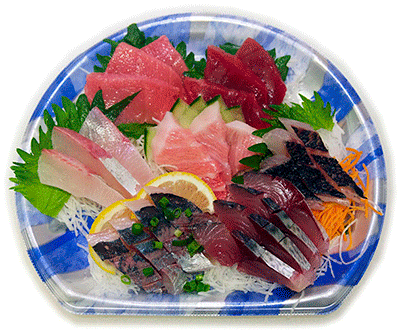

The name is "Minimum syunsen assorted sashimi" because many different fish species are served little by little. Assorted 7 kinds of sashimi including large toro and medium toro of cultured raw bluefin tuna, so if this is a selling price of 1,280 yen, it should sell.
In this way, I have come to think that it is not necessary to stick to natural fish just because it is syunsen assorted sashimi. In short, it is "the splender of the combination". If you try to make assorted sashimi with only large toro, medium toro, and red fresh of raw bluefin tuna, even if it is a poor volume, you will have to put a ridiculously expensive selling price. However, if you do this, you can make assorted sashimi with good cost performance with a good balance between volume and selling price.
Next, we will upgrade further and challenge the "luxury syunsen assorted sashimi", which is a combination of hot water frost of tilefish, which is positioned as the highest rank of natural fish, and fatty tuna of raw bluefin tuna.
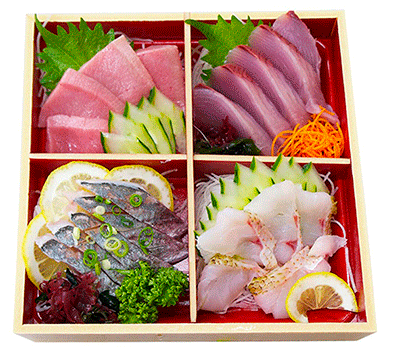
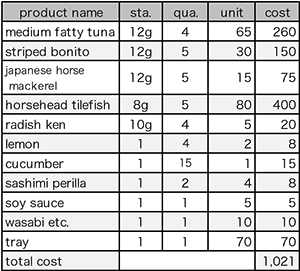
A folding box tray suitable for the high-class fish tilefish was used for this container to create a high-class feeling. The cost of using fresh tilefish for sashimi would still exceed 1,000 yen. But if you think about it, if you can buy assorted sashimi with hot water frost of tilefish sashimi, which you can only taste at a high-class restaurant, it's definitely a bargain. .. This is possible because it is possible to combine it with relatively cheaply procured fish such as natural horse mackerel and natural striped bonito, and if it is combined with amberjack or raw salmon of farmed fish, the cost will jump immediately.
Don't get me wrong, syunsen assorted sashimi isn't about proposing high-volume products at low prices. By using natural fish for assorted sashimi, you can demonstrate "the splender of the combination" and make it a product that you can feel the cost performance even if the selling price is a little high. Then, you can sell the high-priced "luxury syunsen assorted sashimi".
Don't make the fish counter where the sashimi staff makes only manual sashimi like a robot every day. The person in charge of sashimi manufacturing wants to make customers happy by providing attractive sashimi by not only their experience, technique and knowledge, but also wisdom.
The person in charge of sashimi is the job of the most talented human resources in the fishery sector. I want you to take pride in your professionalism and continue to produce attractive sashimi to the world.
| Please access the following URL if you want to secure using SSL. All pages in the site will be secure pages. |
https://secure02.blue.shared-server.net/www.fish-food.co.jp/message english 7.2022.html |
An opinion and the communication are to iinfo@fish food times
Date of updating 1 Jul. 2022
